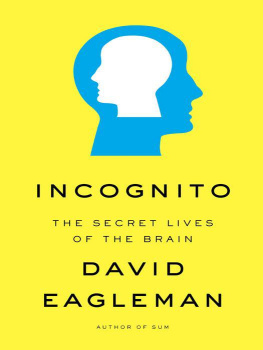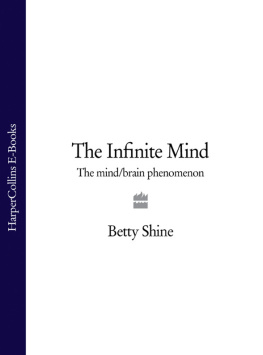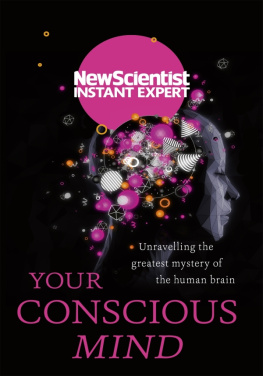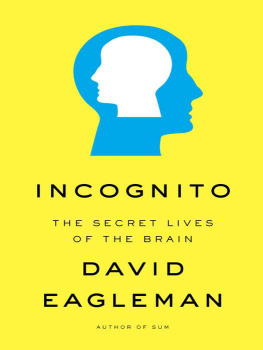Also by David Eagleman
Sum
Why the Net Matters
Wednesday Is Indigo Blue
Copyright 2011 by David Eagleman
All rights reserved. Published in the United States by Pantheon Books, a division of Random House, Inc., New York. Originally published in Great Britain by Canongate Books Ltd., Edinburgh.
Pantheon Books and colophon are registered trademarks of Random House, Inc.
Figure on Elsevier.
Library of Congress Cataloging-in-Publication Data
Eagleman, David.
Incognito : the secret lives of the brain / David Eagleman.
p. cm.
Includes bibliographical references and index.
eISBN: 978-0-307-37978-8
1. Subconsciousness. 2. Brain. I. Title.
BF 315. E 25 2011 153dc22 2010053184
www.pantheonbooks.com
Jacket design by Peter Mendelsund
v3.1
Man is equally incapable of seeing the nothingness from which he emerges and the infinity in which he is engulfed.
Blaise Pascal, Penses
Contents
Theres Someone in My Head, But Its Not Me
Take a close look at yourself in the mirror. Beneath your dashing good looks churns a hidden universe of networked machinery. The machinery includes a sophisticated scaffolding of interlocking bones, a netting of sinewy muscles, a good deal of specialized fluid, and a collaboration of internal organs chugging away in darkness to keep you alive. A sheet of high-tech self-healing sensory material that we call skin seamlessly covers your machinery in a pleasing package.
And then theres your brain. Three pounds of the most complex material weve discovered in the universe. This is the mission control center that drives the whole operation, gathering dispatches through small portals in the armored bunker of the skull.
Your brain is built of cells called neurons and gliahundreds of billions of them. Each one of these cells is as complicated as a city. And each one contains the entire human genome and traffics billions of molecules in intricate economies. Each cell sends electrical pulses to other cells, up to hundreds of times per second. If you represented each of these trillions and trillions of pulses in your brain by a single photon of light, the combined output would be blinding.
The cells are connected to one another in a network of such staggering complexity that it bankrupts human language and necessitates new strains of mathematics. A typical neuron makes about ten thousand connections to neighboring neurons. Given the billions of neurons, this means there are as many connections in a single cubic centimeter of brain tissue as there are stars in the Milky Way galaxy.
The three-pound organ in your skullwith its pink consistency of Jell-ois an alien kind of computational material. It is composed of miniaturized, self-configuring parts, and it vastly outstrips anything weve dreamt of building. So if you ever feel lazy or dull, take heart: youre the busiest, brightest thing on the planet.
Ours is an incredible story. As far as anyone can tell, were the only system on the planet so complex that weve thrown ourselves headlong into the game of deciphering our own programming language. Imagine that your desktop computer began to control its own peripheral devices, removed its own cover, and pointed its webcam at its own circuitry. Thats us.
And what weve discovered by peering into the skull ranks among the most significant intellectual developments of our species: the recognition that the innumerable facets of our behavior, thoughts, and experience are inseparably yoked to a vast, wet, chemical-electrical network called the nervous system. The machinery is utterly alien to us, and yet, somehow, it is us.
THE TREMENDOUS MAGIC
In 1949, Arthur Alberts traveled from his home in Yonkers, New York, to villages between the Gold Coast and Timbuktu in West Africa. He brought his wife, a camera, a jeep, andbecause of his love of musica jeep-powered tape recorder. Wanting to open the ears of the western world, he recorded some of the most important music ever to come out of Africa. But Alberts ran into social troubles while using the tape recorder. One West African native heard his voice played back and accused Alberts of stealing his tongue. Alberts only narrowly averted being pummeled by taking out a mirror and convincing the man that his tongue was still intact.
Its not difficult to see why the natives found the tape recorder so counterintuitive. A vocalization seems ephemeral and ineffable: it is like opening a bag of feathers which scatter on the breeze and can never be retrieved. Voices are weightless and odorless, something you cannot hold in your hand.
So it comes as a surprise that a voice is physical. If you build a little machine sensitive enough to detect tiny compressions of the molecules in the air, you can capture these density changes and reproduce them later. We call these machines microphones, and every one of the billions of radios on the planet is proudly serving up bags of feathers once thought irretrievable. When Alberts played the music back from the tape recorder, one West African tribesman depicted the feat as tremendous magic.
And so it goes with thoughts. What exactly is a thought? It doesnt seem to weigh anything. It feels ephemeral and ineffable. You wouldnt think that a thought has a shape or smell or any sort of physical instantiation. Thoughts seem to be a kind of tremendous magic.
But just like voices, thoughts are underpinned by physical stuff. We know this because alterations to the brain change the kinds of thoughts we can think. In a state of deep sleep, there are no thoughts. When the brain transitions into dream sleep, there are unbidden, bizarre thoughts. During the day we enjoy our normal, well-accepted thoughts, which people enthusiastically modulate by spiking the chemical cocktails of the brain with alcohol, narcotics, cigarettes, coffee, or physical exercise. The state of the physical material determines the state of the thoughts.
And the physical material is absolutely necessary for normal thinking to tick along. If you were to injure your pinkie in an accident youd be distressed, but your conscious experience would be no different. By contrast, if you were to damage an equivalently sized piece of brain tissue, this might change your capacity to understand music, name animals, see colors, judge risk, make decisions, read signals from your body, or understand the concept of a mirrorthereby unmasking the strange, veiled workings of the machinery beneath. Our hopes, dreams, aspirations, fears, comic instincts, great ideas, fetishes, senses of humor, and desires all emerge from this strange organand when the brain changes, so do we. So although its easy to intuit that thoughts dont have a physical basis, that they are something like feathers on the wind, they in fact depend directly on the integrity of the enigmatic, three-pound mission control center.
The first thing we learn from studying our own circuitry is a simple lesson: most of what we do and think and feel is not under our conscious control. The vast jungles of neurons operate their own programs. The conscious youthe I that flickers to life when you wake up in the morningis the smallest bit of whats transpiring in your brain. Although we are dependent on the functioning of the brain for our inner lives, it runs its own show. Most of its operations are above the security clearance of the conscious mind. The I















